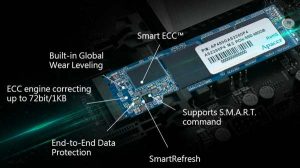Apacer AS2880P4 M.2 PCIe Gen3 x4 Up to 480GB SSD With 3D NAND TLC
NVMe 1.3-compliant, up to 3,200 and 2,000MB/s RW speeds, and 360,000 IO/s
This is a Press Release edited by StorageNewsletter.com on April 18, 2019 at 2:36 pmApacer Technology, Inc.‘s AS2880P4 M.2 PCIe Gen3 x4 SSD boasts performance at reasonable price.
This SSD brings reading/writing speeds of 3,200/2,000MB/s and 360,000 IO/s within reach of eSports players. NVMe 1.3-compliant, the AS2880P4 uses the 3D NAND TLC technology to make it an compact, high-capacity that frees up space for you to further modify and expand gaming devices. Its maximum capacity of 480GB makes it for hardcore eSports players, post-production CAD 3D modeling designers, and users demanding high speed and high capacity!
AS2280P4: power with friendly price tag
The M.2 PCIe Gen3 x4 is a choice for high performance demands in ultra-thin notebooks, high-power computers, e-sports consoles, mini-PCs, and embedded devices. As a trend-defining SSD brand, the company has led the market with its PCIe Gen3 x4 NVMe 1.3 SSD and again with its successor, the AS2280P4.
Using the 3D NAND TLC stacking technology, the 22x80mm compact body accommodates up to 480GB of storage space, while the thin version is 2.25mm, which takes up minimal space within gamers’ devices and gives them more space for their other creative set-ups and modifications.
The firm’s proprietary SSD tuning technology boosts read-write speeds to 3,200/2,000MB/s and up to 360,000 IO/s. Always a proponent of ‘Super powers to everyone’, the company offers the upgraded AS2280P4 without upgrading the price. N
Built-in protections, fast and steady
To ensure users of a high-speed experience, the AS2280P4 SSD has built-in protection technology to ensure data integrity and stability: S.M.A.R.T. monitoring technology monitors the SSD drive’s health status and improves system stability. The 120b/2kb ECC technology finds and kills bugs as you go, while ‘End-to-End Data Protection’ verifies the integrity and correctness of data and keeps data channels safe, while finally, wear-leveling prolongs the lifecycle of the SDD, keeping it stable and fast for longer.















 Subscribe to our free daily newsletter
Subscribe to our free daily newsletter

